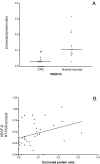VEGF-A, VEGF-C, and VEGF-D in colorectal cancer progression
- PMID: 11687953
- PMCID: PMC1506210
- DOI: 10.1038/sj.neo.7900186
VEGF-A, VEGF-C, and VEGF-D in colorectal cancer progression
Abstract
We aimed to assess the relationship of the angiogenic cytokines VEGF-A, VEGF-C, and VEGF-D and their receptors VEGFR-2 and VEGFR-3 in the adenoma-carcinoma sequence and in metastatic spread of colorectal cancer (CRC). mRNA expression levels were measured using semi-quantitative reverse transcription polymerase chain reaction in 70 CRC (35 with paired mucosae) and 20 adenomatous polyps. Immunohistochemistry and ELISA assessed protein expression. VEGF-D mRNA expression was significantly lower in both polyps and CRCs compared with normal mucosa (P=.0002 and.002, respectively), whereas VEGF-A and VEGF-C were significantly raised in CRCs (P=.006 and.004, respectively), but not polyps (P=.22 and P=.5, respectively). Receptor expression was similar in tumor tissue and normal mucosae. Tumors with lymph node metastases had significantly higher levels of VEGF-A compared with non-metastatic tumors (P=.043). There was no association between VEGF-C or VEGF-D and lymphatic spread. The decrease in VEGF-D occurring in polyps and carcinomas may allow the higher levels of VEGF-A and VEGF-C to bind more readily to the VEGF receptors, and produce the angiogenic switch required for tumor growth. Increased expression of VEGF-A within CRCs was associated with lymphatic metastases, and therefore, this member of the VEGF family may be the most important in determining metastatic spread.
Figures





References
-
- Folkman J. What is the evidence that tumors are angiogenesis-dependent? J Natl Cancer Inst. 1990;82:4–6. - PubMed
-
- Hanahan D, Folkman J. Patterns and emerging mechanisms of the angiogenic switch during tumorigenesis. Cell. 1996;86:353–364. - PubMed
-
- Wei MH, Popescu NC, Lerman MI, Merrill MJ, Zimonjic DB. Localization of the human vascular endothelial growth factor gene, VEGF, at chromosome 6p12. Hum Genet. 1996;97:794–797. - PubMed
-
- Houck KA, Leung DW, Rowland AM, Winer J, Ferrara N. Dual regulation of vascular endothelial growth factor bioavailability by genetic and proteolytic mechanisms. J Biol Chem. 1992;267:26031–26037. - PubMed
Publication types
MeSH terms
Substances
LinkOut - more resources
Full Text Sources
Other Literature Sources
Medical
Miscellaneous
